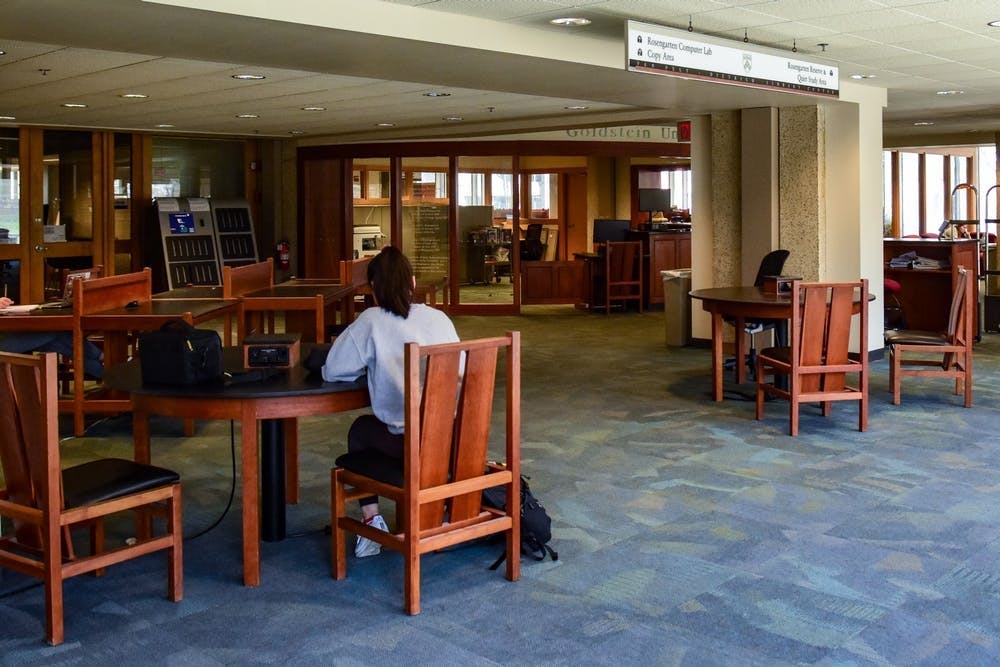While engulfed by the silence of Van Pelt–Dietrich Library’s 60–year–old walls, lengthy papers write themselves faster, grinding for an upcoming midterm becomes (a little) less daunting, and typing out tedious discussion posts is a bit easier.
If I were to describe Van Pelt to someone who has never entered, I would tell them that it has something for everyone. For the studier in need of absolute silence, there's the Moelis Family Grand Reading Room. Any student who's ever stepped into the room understands the all–consuming self–consciousness that you feel as you approach an empty seat and remove your computer from your backpack, color rushing to your cheeks as your papers rustle just a little too loudly.
For the social studier, there are the group study rooms. You enter with a comically large iced coffee and high aspirations for all of the work that you're about to complete; you leave with melting ice cubes at the bottom of your empty cup and four hours behind you spent chatting and typing 12 words into a Google Doc.
Last semester, Van Pelt was just a distant memory to upperclassmen and a figment of first years’ imaginations. We studied in our bedrooms for hours a day, dreaming of a time when a change of scenery would be a possibility. But no longer—our beloved study spot has begun its gradual reopening, and if you're anything like me, this is cause for great excitement.
The intended start date for Van Pelt’s phased reopening was Feb. 1, but a snow storm postponed it until Feb. 3. The space currently open is on the ground floor, and it includes 25 seats in the Rosengarten Quiet Study Area, 19 seats in the Goldstein Undergraduate Study Center, and four individual study rooms. These spaces are open on a reservation–basis Monday through Friday from 11 a.m.–7 p.m.
All current students, whether graduate, professional, or undergraduate, are eligible to reserve seats. Those who make a reservation must comply with Penn's COVID–19 testing protocols and present a green PennOpen Pass and a reservation confirmation upon entry. Afterwards, students can find their socially–distant seat and study for anywhere from one to three hours.
Jon Shaw, associate vice provost and deputy university librarian, is responsible for overseeing library operations. He explains that Van Pelt’s phased reopening has been extraordinarily successful thus far.
“The feedback has been great, and students have been saying how easy it is to reserve and find your seat," he says. "The ground floor is extremely spacious, and the social distancing between seats is great."
Wellness ambassadors are responsible for walking around the space and ensuring that students remain distanced and keep their masks on. “So far there have been very few incidents, even minor incidents. Practically none. It shows that students have been abiding by the student Compact well while in our space,” Shaw says.
Library staff have been assessing demand on a weekly basis to determine when it's appropriate to open up more rooms. Once the library reaches a certain occupancy, they hope to further expand spaces in Van Pelt, and potentially open more libraries.
“Upon reopening, we were considering whether it was important to open up spaces, and it really is," Shaw says. "It’s important to network back into the spaces that we’re used to, and we’ve opened these spaces up with health and safety guidelines at the forefront. From all the use that we’ve seen, it’s shown us how important it is. The library is part of the fabric of the student experience."
John Pollack, curator for the Kislak Center, wants to remind students about the information resources that have been available to students, even prior to reopening. Penn has purchased countless collections and books in a virtual format for student use while at home, and chat and video consultation services are available as well.
Students are able to browse resources online by call number. They may also request to have books mailed to them, pick them up from a locker, or have portions of books scanned for use.
“I’m involved in the conversations about how we can figure out helping people get their work done as best they can during the COVID–19 era. This changes every week, every day, and with every message from the provost, but we’re doing our very best,” Pollack says.

